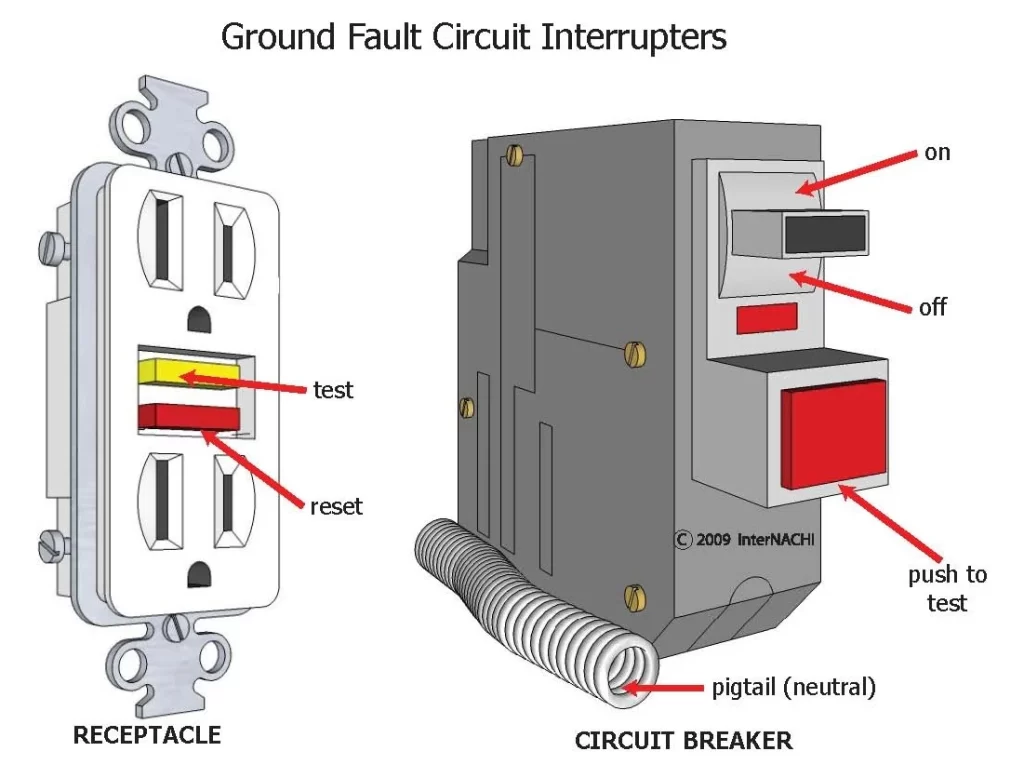What is a GFCI?
A Ground-Fault Circuit Interrupter (GFCI) is an electrical device that cuts power if it detects an imbalance in the electrical current, which can happen when electricity “leaks” through something—like a person who touches a live wire while grounded. This type of interruption can prevent potentially fatal shocks, unlike standard breakers, which primarily guard against overloads and short circuits. With about 300 electrocution deaths each year, GFCIs are now standard in new buildings and recommended for older homes.

The History of GFCIs
GFCIs have been around since the 1950s, starting with a device designed for South African mines by Henri Rubin. This early model could detect current leaks of up to 250 mA and shut off power immediately, protecting miners from fatal shocks. In 1961, Charles Dalziel developed the first transistorized GFCI, though early versions had issues with nuisance tripping. By the 1980s, GFCIs were built directly into outlets, and advances have since made them more reliable.
NEC Requirements for GFCIs
The National Electrical Code (NEC) started recommending GFCIs in 1968 for pool lights, expanding over the years to other areas prone to water exposure, like bathrooms, kitchens, and outdoor outlets. Requirements continued to broaden in the 1980s and ’90s, adding basements, garages, crawlspaces, and even rooftops. By 1996, GFCIs became required for all temporary wiring, including construction sites and events like carnivals.
Kansas City GFCI requirements are adopted from the 2017 NFPA 70 (at the time of this writing.) It contains additional updates relevant to GFCI use, as well as some exceptions for certain areas. The 2017 language is presented here for reference.
NFPA 70 – 2017 on GFCI’s
210.8 Ground-Fault Circuit-Interrupter Protection for Personnel
Ground-fault circuit-interrupter protection for personnel shall be provided as required in 210.8(A) through (E). The ground-fault circuit interrupter shall be installed in a readily accessible location.
Informational Note No. 1: See 215.9 for ground-fault circuit-interrupter protection for personnel on feeders.
Informational Note No. 2: See 422.5(A) for GFCI requirements for appliances.
For the purposes of this section, when determining distance from receptacles the distance shall be measured as the shortest path the cord of an appliance connected to the receptacle would follow without piercing a floor, wall, ceiling, or fixed barrier, or passing through a door, doorway, or window.
(A) Dwelling Units
All 125-volt, single-phase, 15- and 20-ampere receptacles installed in the locations specified in 210.8(A)(1) through (10) shall have ground-fault circuit-interrupter protection for personnel.
- Bathrooms
- Garages, and also accessory buildings that have a floor located at or below grade level not intended as habitable rooms and limited to storage areas, work areas, and areas of similar use
- OutdoorsException to (3): Receptacles that are not readily accessible and are supplied by a branch circuit dedicated to electric snow-melting, deicing, or pipeline and vessel heating equipment shall be permitted to be installed in accordance with 426.28 or 427.22, as applicable.
- Crawl spaces — at or below grade level
- Unfinished portions or areas of the basement not intended as habitable roomsException to (5): A receptacle supplying only a permanently installed fire alarm or burglar alarm system shall not be required to have ground-fault circuit-interrupter protection.Informational Note: See 760.41(B) and 760.121(B) for power supply requirements for fire alarm systems.Receptacles installed under the exception to 210.8(A)(5) shall not be considered as meeting the requirements of 210.52(G).
- Kitchens — where the receptacles are installed to serve the countertop surfaces
- Sinks — where receptacles are installed within 1.8 m (6 ft) from the top inside edge of the bowl of the sink
- Boathouses
- Bathtubs or shower stalls — where receptacles are installed within 1.8 m (6 ft) of the outside edge of the bathtub or shower stall
- Laundry areas
Testing Your GFCI
Testing a GFCI is simple and important to ensure ongoing protection. Once installed, test the GFCI by plugging in a light and pressing the “TEST” button; the light should go off, and the “RESET” button should pop out. If the light doesn’t turn off, there may be a wiring issue—call an electrician. If the GFCI fails to reset, it needs replacing.
Monthly testing can ensure your GFCIs continue to work correctly, keeping you and your home safer from electric shock.

Recent Comments